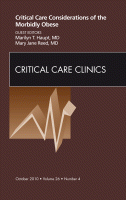Critical Care for Critically Obese Patients
Wednesday, October 27, 2010 Yes, the usual term is “morbidly” obese (a term I do not like), but today’s post is simply to draw my readers’ attention to a special issue of Critical Care Clinics dedicated entirely to the critical care of patients with severe obesity.
Yes, the usual term is “morbidly” obese (a term I do not like), but today’s post is simply to draw my readers’ attention to a special issue of Critical Care Clinics dedicated entirely to the critical care of patients with severe obesity.
This special issue is edited by Marilyn Haupt and Mary Jane Reed from Temple University School of Medicine, Danville, who describe the timeliness of this collection of articles as follows:
“As critical care practitioners, we have seen our ICU transformed over the last 20 years from a facility challenged with the care of an occasional morbidly obese patient to one that cares for multiple morbidly obese patients on a daily basis. Nevertheless, our approach to the management continues to be primarily empiric and without guidance from clinical research directed toward this population of patients. Although research is evolving in this area, large gaps in knowledge persist. Optimal dosing, for example, is unknown for many drugs, including those that may be lifesaving. Although a modest body of literature exists on antibiotic dosing in the obese, the studies addressing dosing of cardiac medications in these patients are infrequent and sporadic. Controversy continues to persist over whether a calorie-restricted diet is safe or beneficial in the critically ill obese patient.“
The issue contains a total of 21 articles ranging from the “obesity paradox” to hands-on topics like airway management, tracheostomy, vascular access, lumbar puncture, and radiological procedures.
There are articles on cardiovascular and pulmonary care, acute kidney failure, gastrointestinal complications, immunological changes, endocrine problems, venous thromoboembolic disease, hematological considerations, and pharmacotherapy.
Special situations and populations include trauma and disasters, severely obese children and pregnant mothers, and the bariatric surgery patient in the intensive care unit.
The series sensibly ends with a note on sensitivity in caring for patients with obesity – whereby, my only criticism of the entire series is in the frequent use of the word “obese” as a noun rather than an adjective (see my previous post on this issue).
With regard to this series, the editors note:
“Practitioners and clinical researchers with experience and interest have authored these articles, providing scientific backup whenever possible as well as wisdom and common sense that derives from years of practice. We hope that clinicians will find useful applications of this knowledge base and that clinical researchers will recognize areas requiring investigation.“
This is not a problem that is going away anytime soon, and the more clinicians familiarise themselves with these issues, the better they will be able to help their patients.
AMS
Hamilton, Ontario
Haupt MT, & Reed MJ (2010). Preface. Critical care clinics, 26 (4) PMID: 20970042


